Welcome to Saturday Sparks! This week, we’re exploring the intricate and timeless art of embroidery, a craft that transforms simple thread and fabric into works of beauty and meaning. Whether you’re stitching initials onto a gift, creating detailed wall art, or adding personality to your favorite clothing, embroidery offers a creative outlet that’s both soothing and deeply personal.



At its core, embroidery is a quiet conversation between patience and imagination. Each stitch adds texture and story to the fabric, inviting you to slow down and be present in the process. It’s a craft that connects us not only to our creativity, but also to a long lineage of makers who have used thread to express, decorate, and communicate across generations.

Historically, embroidery has appeared in nearly every culture around the world, from the delicate silk work of ancient China to the richly textured tapestries of medieval Europe and the bold geometric patterns of Central and South America. Originally used to embellish garments, linens, and ceremonial fabrics, it has evolved into both an art form and a meditative hobby. Today, it’s experiencing a revival among modern makers who appreciate its blend of tradition, mindfulness, and self-expression.
Part craft, part art, and part reflection, embroidery offers a gentle reminder that creativity doesn’t always come from speed or perfection — sometimes, it comes from simply taking the time to create something meaningful, one stitch at a time.
What is Embroidery
Embroidery is the craft of decorating fabric using a needle and thread to form designs, patterns, or textures. The process may be simple or intricate, but at its heart, it’s about using stitches to bring imagery and detail to life. Unlike sewing, which joins pieces of fabric together, embroidery focuses on embellishment, transforming a plain surface into something expressive and unique.

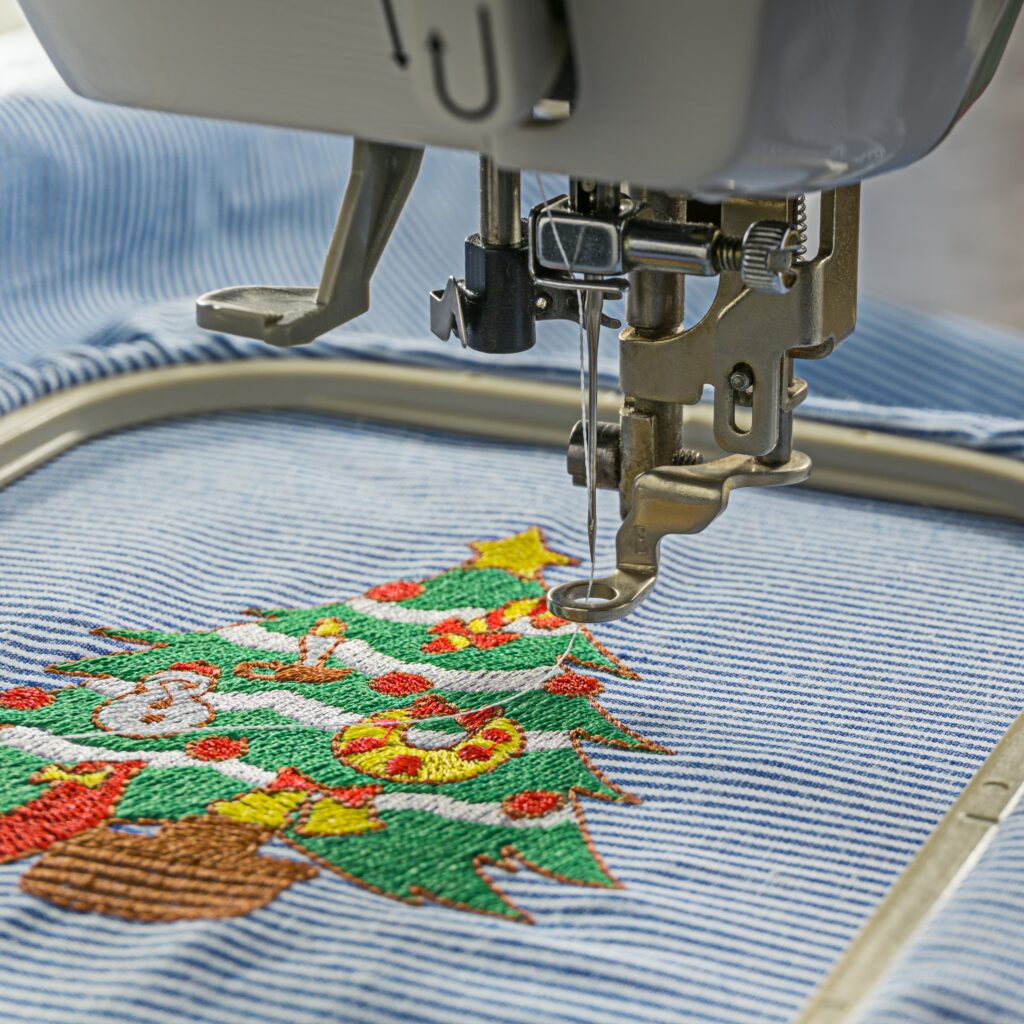
There are two primary forms of embroidery: hand embroidery and machine embroidery. Hand embroidery is the traditional method, using a threaded needle guided by hand to create each stitch. This approach emphasizes creativity and precision, allowing for greater control over texture and detail. Machine embroidery, on the other hand, uses computer-guided stitching to produce designs quickly and consistently. While the technique differs, both share the same foundation of thread artistry and design.

The tools required are straightforward but purposeful. An embroidery hoop holds the fabric taut, ensuring smooth, even stitches.
Embroidery floss, a soft, six-strand thread available in a wide range of colors, adds dimension and vibrancy to designs.
Needles vary in size and sharpness depending on the fabric and stitch type, while small embroidery scissors make it easy to trim threads with precision.
There are dozens of stitch types, but beginners often start with foundational techniques like the backstitch, satin stitch, and French knot. Each stitch serves a purpose: the backstitch outlines, the satin stitch fills areas with color, and the French knot adds raised, textural detail. As you gain confidence, you can experiment with more complex stitches such as chain, split, or feather stitches, combining them to achieve layered effects.
Embroidery can be applied in countless ways, from decorating clothing, bags, and linens to creating framed hoop art or wall hangings.
Modern styles often blend traditional stitches with contemporary themes, such as minimalist line art, abstract patterns, or embroidered typography.
The versatility of embroidery makes it a favorite among crafters who want to create meaningful, personalized pieces that reflect their style and imagination.
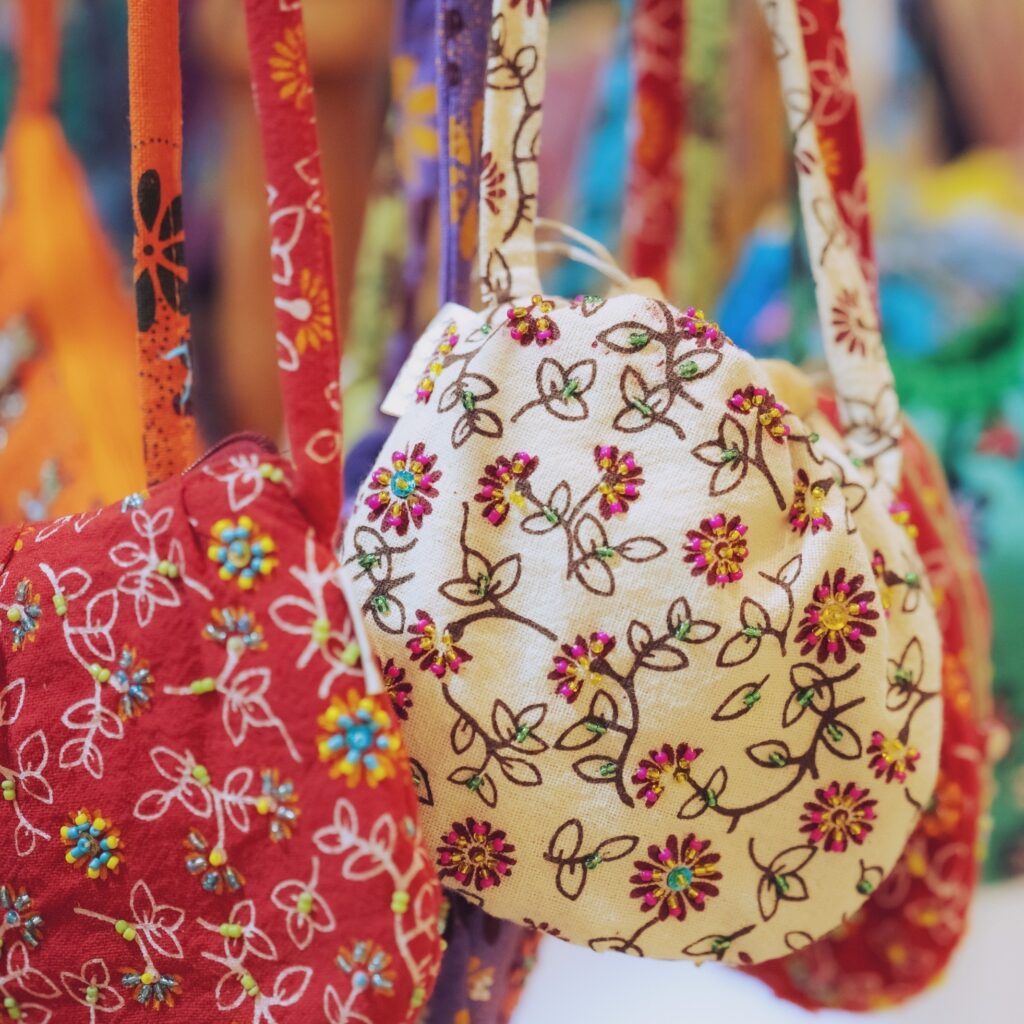
While its techniques can be learned in a single afternoon, embroidery rewards patience and practice. Over time, it becomes more than a craft, it’s a form of meditation in motion, where your hands, eyes, and creativity work in quiet rhythm to produce something truly one-of-a-kind.
The Benefits of Embroidery
Embroidery encourages self-expression and creativity. Each piece is an open canvas, allowing you to experiment with color, texture, and design. Whether you’re stitching a name on a towel or creating an elaborate pattern, embroidery gives you the freedom to tell your own story through thread. No two projects are ever the same, every stitch reflects the personality and imagination of its maker.

Embroidery promotes mindfulness and calm. The slow, repetitive motion of stitching naturally draws you into the present moment.
Focusing on each thread and detail helps quiet racing thoughts, reduce stress, and create a sense of peaceful concentration.
For many, embroidery becomes a form of moving meditation, a gentle way to relax and recharge while making something beautiful.
It enhances fine motor skills and coordination. Guiding a small needle through fabric requires precision, dexterity, and control.
Over time, embroidery strengthens hand-eye coordination and improves steadiness in the hands and fingers.
This fine motor practice can even support other creative or everyday tasks that rely on careful, intentional movement.
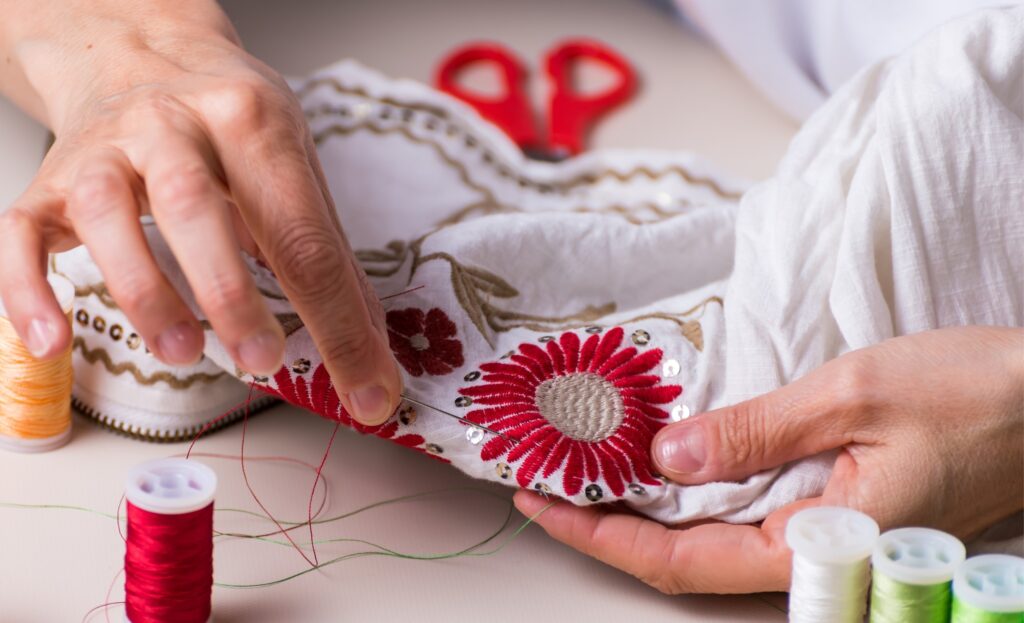
Embroidery is versatile and endlessly customizable. From monogrammed napkins to hand-stitched wall hangings, the possibilities are nearly limitless. You can work with cotton, linen, denim, or even canvas, and choose from a spectrum of thread colors to create anything from subtle designs to bold statement pieces. This adaptability makes embroidery accessible to beginners yet continually engaging for experienced crafters.

It offers a rewarding sense of accomplishment. Watching a design take shape, one stitch at a time, brings both patience and satisfaction.
Finishing an embroidered piece, no matter how small, provides a tangible reminder of what slow, consistent effort can achieve.
It’s a process that celebrates progress as much as completion.
It connects you to tradition and community. Embroidery has deep cultural roots, and engaging with it continues a legacy of craftsmanship that spans centuries. Today, many find community through local workshops, online groups, and social media circles where patterns, techniques, and encouragement are shared freely. This connection to others, and to the craft’s history, adds a meaningful dimension to every project.
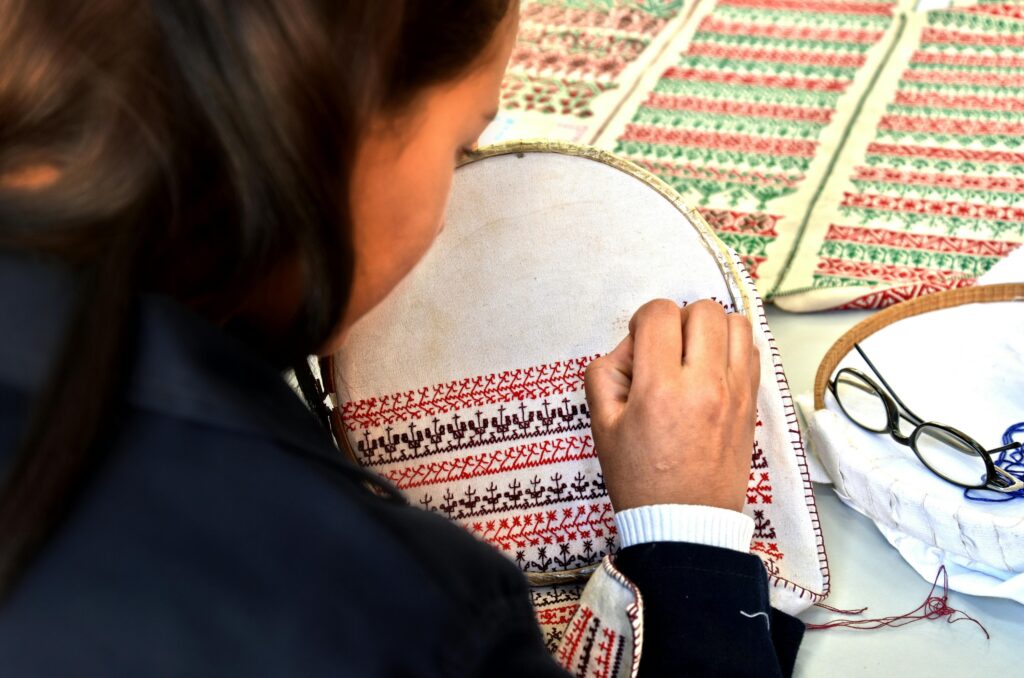
It’s portable and flexible. Unlike many crafts that require large workspaces or heavy tools, embroidery fits in a small bag and can be done almost anywhere. Whether sitting on the porch, traveling, or watching a favorite show, you can bring your project along and stitch at your own pace. Its portability makes it one of the most convenient creative hobbies to enjoy daily.
Getting Started
Gather your essential tools and materials. At minimum, you’ll need an embroidery hoop, fabric, embroidery floss, needles, and scissors. The hoop keeps your fabric taut and your stitches even. For fabric, cotton or linen works well for beginners because of their smooth weave and durability. Embroidery floss — usually made of cotton — comes in a wide range of colors and can be separated into strands to achieve different levels of thickness and texture.
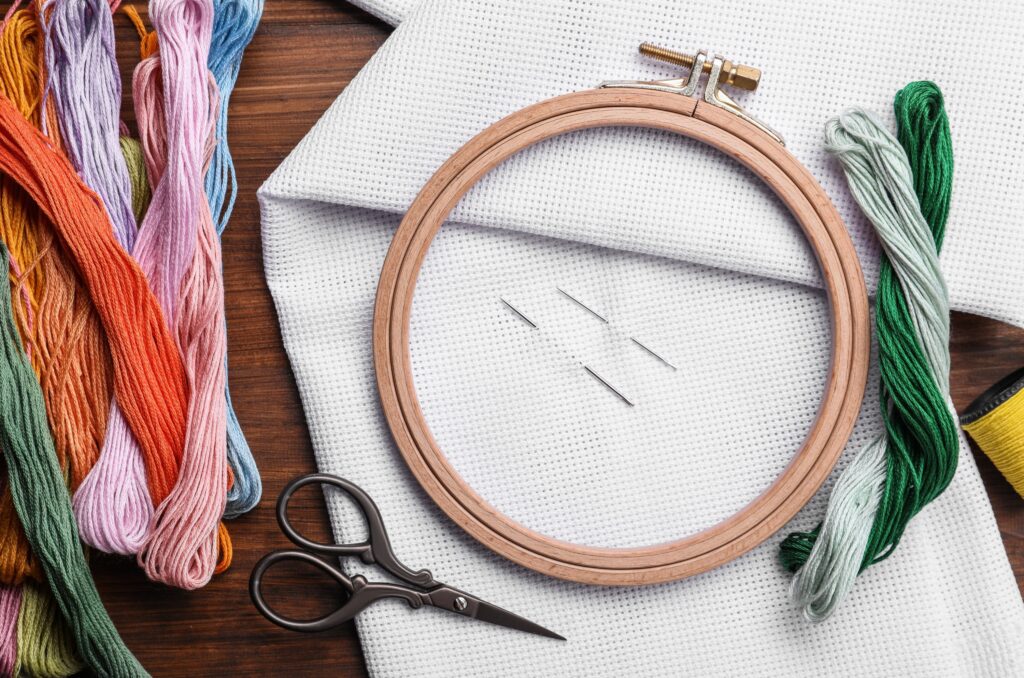
Select your needle carefully. Embroidery needles have larger eyes to accommodate thicker threads, but the size should still match the weight of your fabric. A needle that’s too large may leave visible holes, while one that’s too small can make threading and stitching more difficult.
The best way to begin embroidery is by starting simple. Choose small, beginner-friendly patterns such as flowers, initials, or geometric shapes.
These designs help you learn stitch control and build confidence without feeling overwhelmed. Many free printable templates and beginner patterns are available online, allowing you to practice before moving on to more complex projects.
Learning a few basic stitches is the foundation of embroidery. The backstitch creates clean outlines, the satin stitch fills in solid areas with smooth texture, and the French knot adds raised, decorative accents.
As you grow more comfortable, try experimenting with other stitch types like chain stitch, stem stitch, and split stitch.

Keep your workspace comfortable and well-lit. Good lighting helps you see fine details and prevents eye strain, while sitting with proper posture supports comfort during longer sessions. Embroidery is as much about the process as the result, so taking your time and creating a relaxed environment makes the experience more enjoyable.

Finally, remember that perfection isn’t the goal, progress is. Every stitch, even the uneven ones, is part of your learning journey. Over time, your movements will become more fluid, your tension more consistent, and your designs more intricate. The beauty of embroidery lies in its imperfection — in the human touch that turns fabric and thread into something heartfelt and real.
Resources
One of the best things about embroidery is how easy it is to find helpful materials and inspiration. Whether you prefer learning in person or exploring at your own pace, there are countless resources to help you grow your skills and creativity.

Local craft stores are a great place to begin. Many carry beginner embroidery kits that include everything you need, hoops, fabric, floss, needles, and patterns, all in one package. These kits are ideal for learning the basics and testing different materials before investing in a full setup.
Online craft retailers such as DMC, Joann, or Michaels offer a wide variety of threads, fabrics, and tools. They also feature pattern books, beginner bundles, and specialty items like metallic or variegated floss. Websites like Etsy and independent artist shops often sell unique hand-drawn patterns or digital downloads for modern embroidery projects.
For instruction and technique, YouTube tutorials and online classes are invaluable. Many creators share step-by-step videos on everything from threading a needle to mastering advanced stitches like long and short shading or couching. Free platforms like Skillshare, Creativebug, and Domestika also offer structured courses for different skill levels.
If you enjoy a sense of community, consider joining embroidery groups on social media or craft forums. Facebook groups, Reddit communities, and Instagram hashtags such as #handembroidery and #modernembroidery connect you with fellow stitchers worldwide. These spaces are excellent for sharing progress, asking for advice, and discovering new inspiration.
To expand your technique and understanding, embroidery books and guides provide structured learning and reference material. Titles like The Embroiderer’s Handbook by Country Bumpkin and Doodle Stitching by Aimee Ray offer both classic instruction and creative project ideas. Libraries and secondhand bookshops often carry older volumes filled with timeless techniques and stitch diagrams.
Don’t underestimate the value of simply exploring. Walk through local craft fairs, handmade markets, or fabric shops to find inspiration in textures, colors, and patterns.

Each discovery can spark a new idea, and that sense of curiosity is one of the most rewarding parts of embroidery.

Helpful Tips
Keep your tools organized. It’s easy to misplace needles or scissors when you’re working with multiple colors of thread. A small container or magnetic needle minder keeps your essentials in one place and helps prevent accidents. Keeping your workspace tidy also makes it easier to stay focused and relaxed while stitching.

Use embroidery scissors safely. These fine, pointed scissors are designed for precision cutting but can be hazardous if left unattended.
Always close them when not in use and store them safely out of reach of children or pets.
Handle needles with care. Embroidery needles are small but sharp, so be mindful when stitching, threading, or changing needles.
A thimble can help protect your fingers, especially when pushing through thicker fabric, and makes long stitching sessions more comfortable.

Rest your hands and eyes. Embroidery involves small, repetitive movements that can strain your fingers and wrists over time.

Take short breaks to stretch your hands and shoulders, and look away from your work periodically to rest your eyes. This not only prevents discomfort but also helps maintain accuracy and focus.
Mind your posture and lighting. A supportive chair and good lighting make a world of difference. Poor posture can lead to back or neck strain, while dim light causes eye fatigue.
Choose a comfortable setup with proper light, natural light is best, but a bright desk lamp or adjustable task light works well too.
Store materials properly. Keep threads, fabrics, and finished projects in a clean, dry place to prevent fading or damage. Avoid leaving fabric stretched in the hoop for long periods, as it can distort the weave or leave marks. Removing your work and storing it flat helps preserve its quality over time.
Keep embroidery stress-free. Remember, embroidery is meant to be calming, not stressful. Don’t worry if your stitches aren’t perfect or your lines aren’t straight. The beauty of handmade work lies in its individuality, those small imperfections tell the story of the maker and the moment.

Final Thoughts
Embroidery is more than the art of needle and thread — it’s a quiet reminder of what happens when patience and creativity meet. Each stitch invites stillness, focus, and intention, turning even the simplest fabric into something meaningful. In a world that moves quickly, embroidery slows things down, giving you space to create with care and appreciate the process as much as the result.
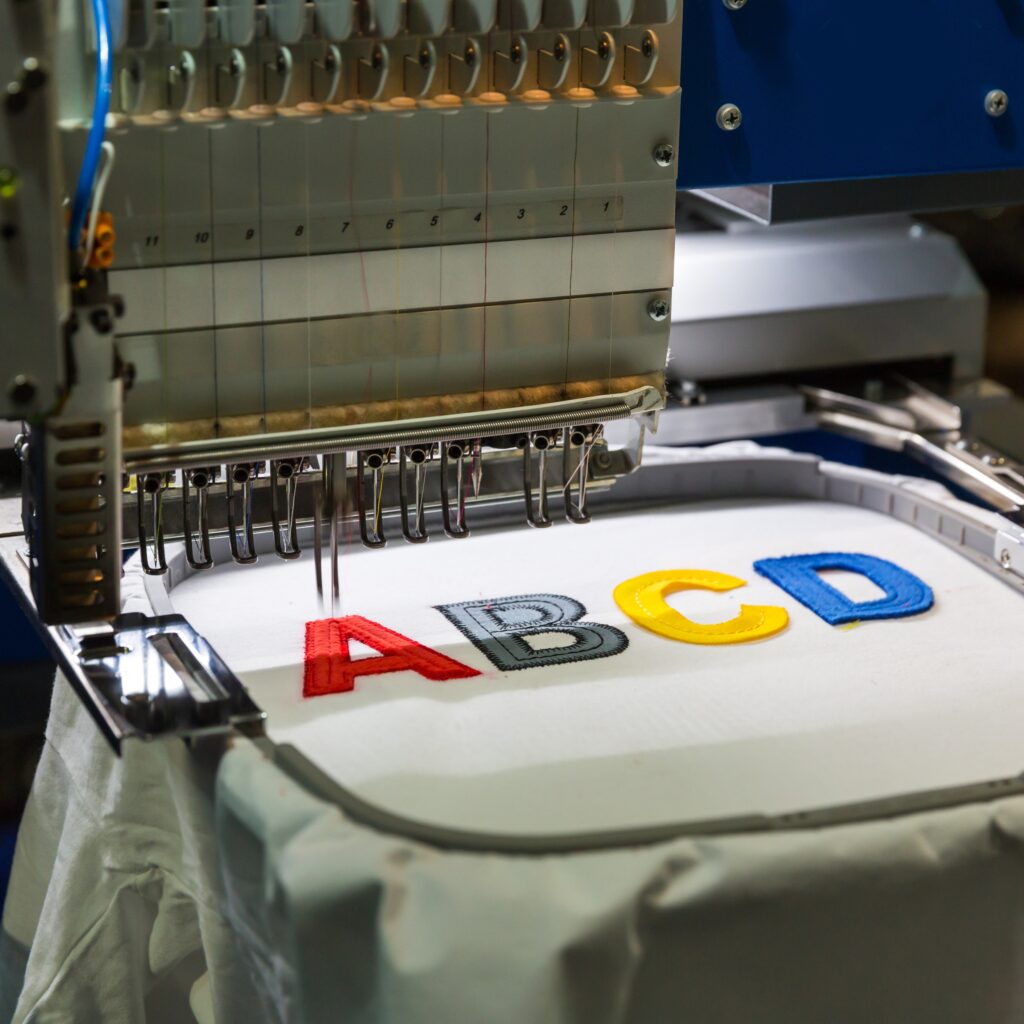


Whether you’re mending something old, crafting something new, or simply exploring color and texture, every stitch connects you to a long tradition of makers who found beauty in the details. There’s something deeply grounding about creating with your hands, it transforms time and attention into something lasting.
So pick up your needle, thread your favorite color, and let your next project unfold one stitch at a time. You might be surprised by how much joy you can create with something so simple.
Have you tried embroidery before? Share your favorite projects in the comments below!
Leave a Reply